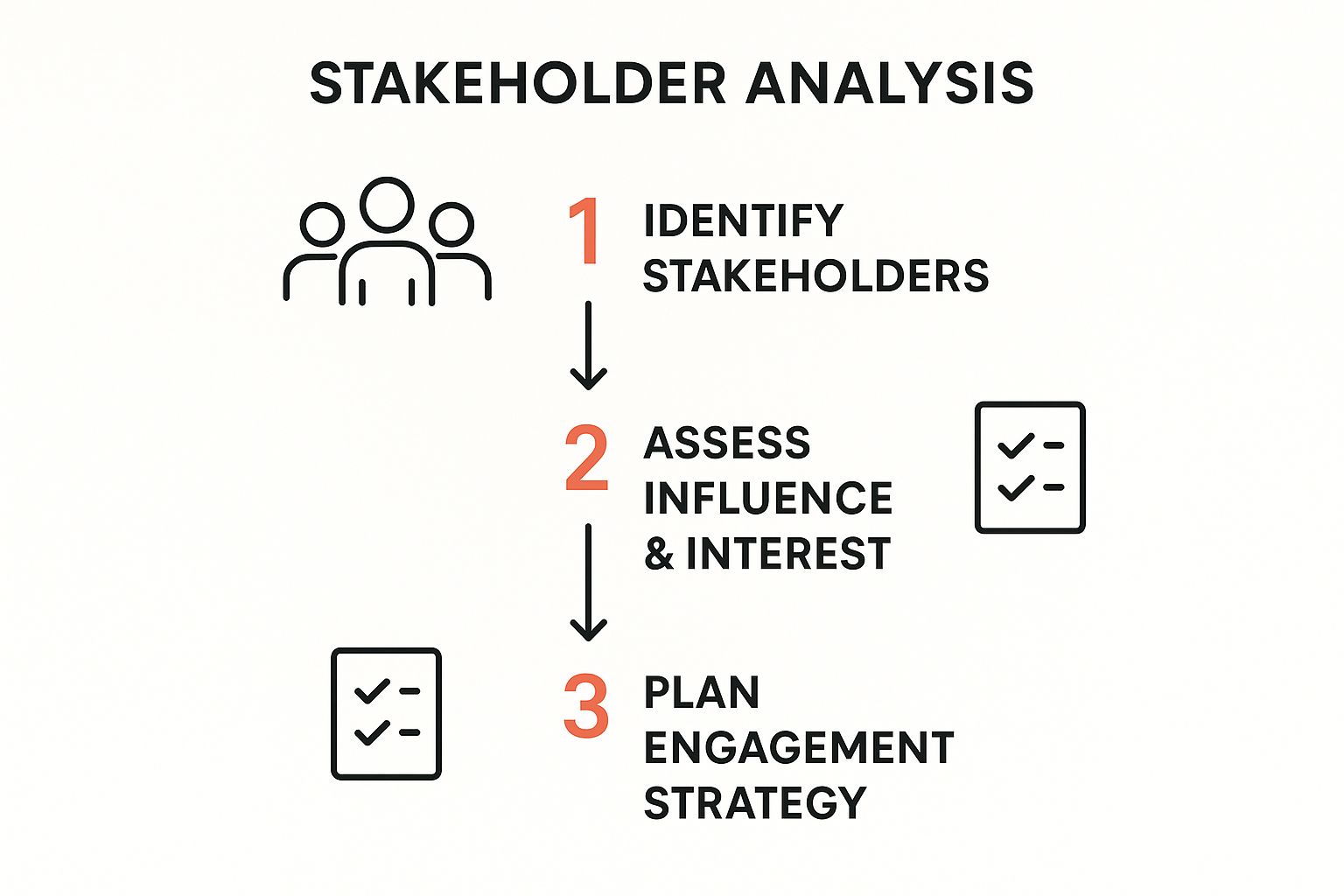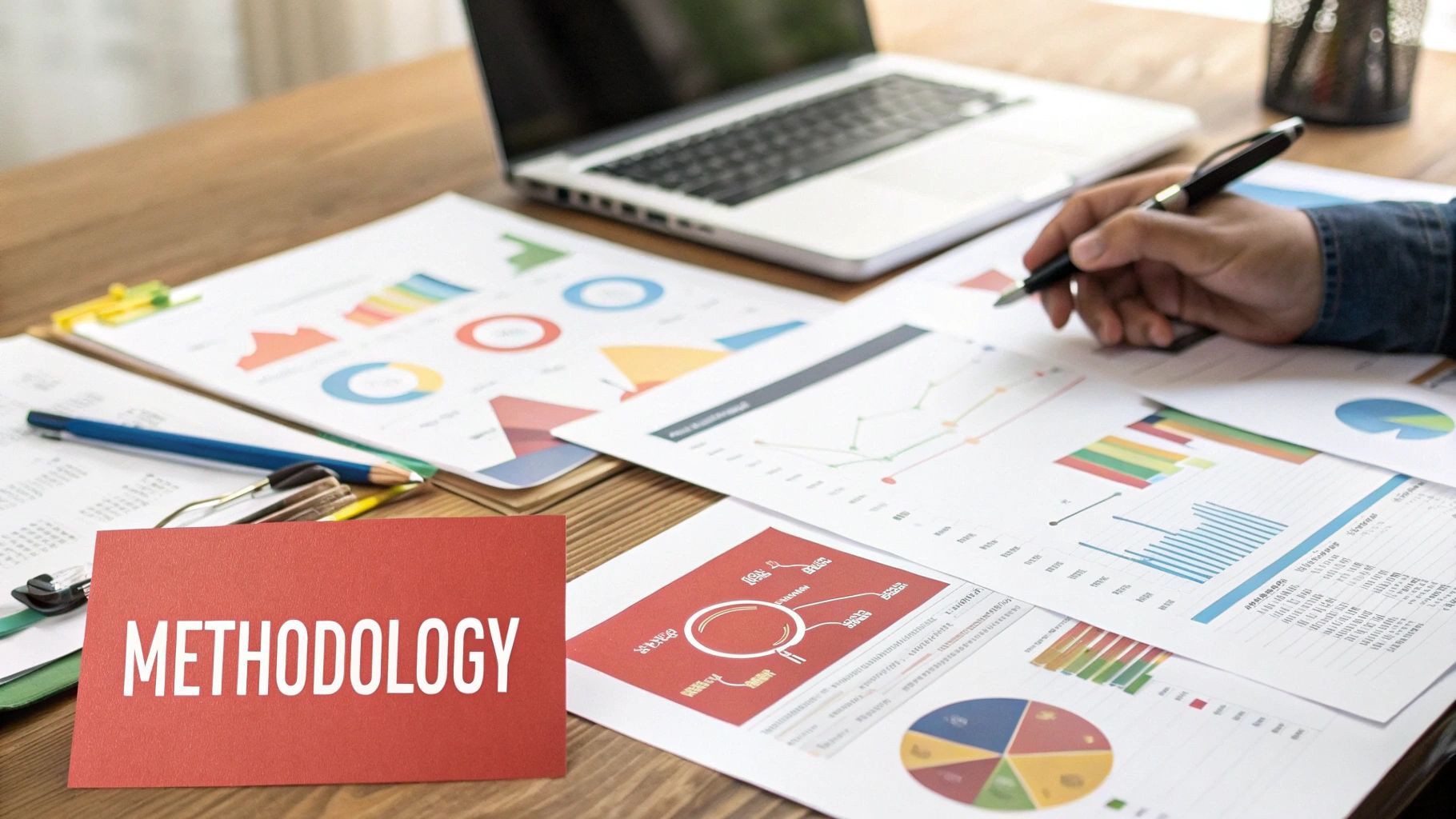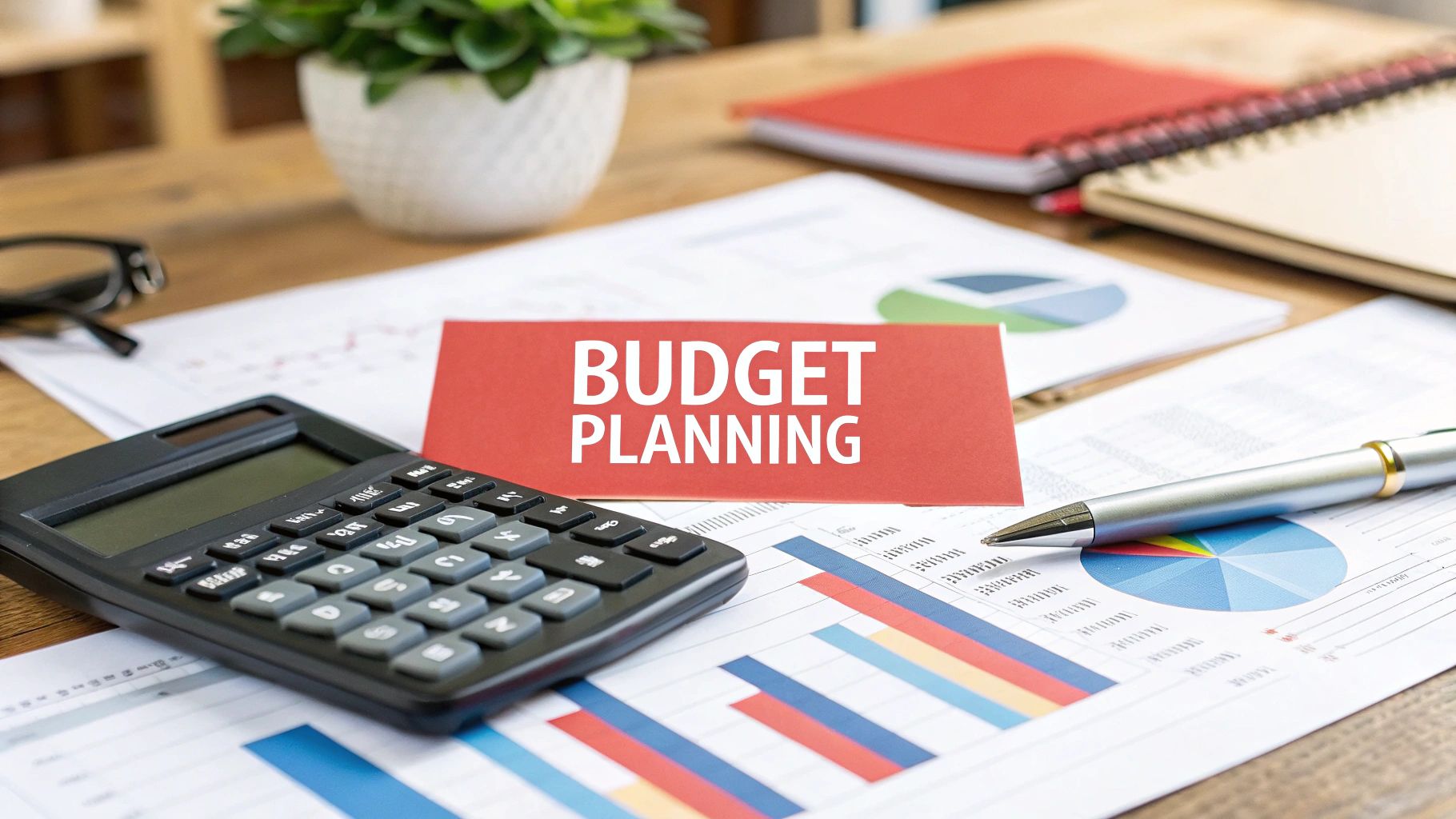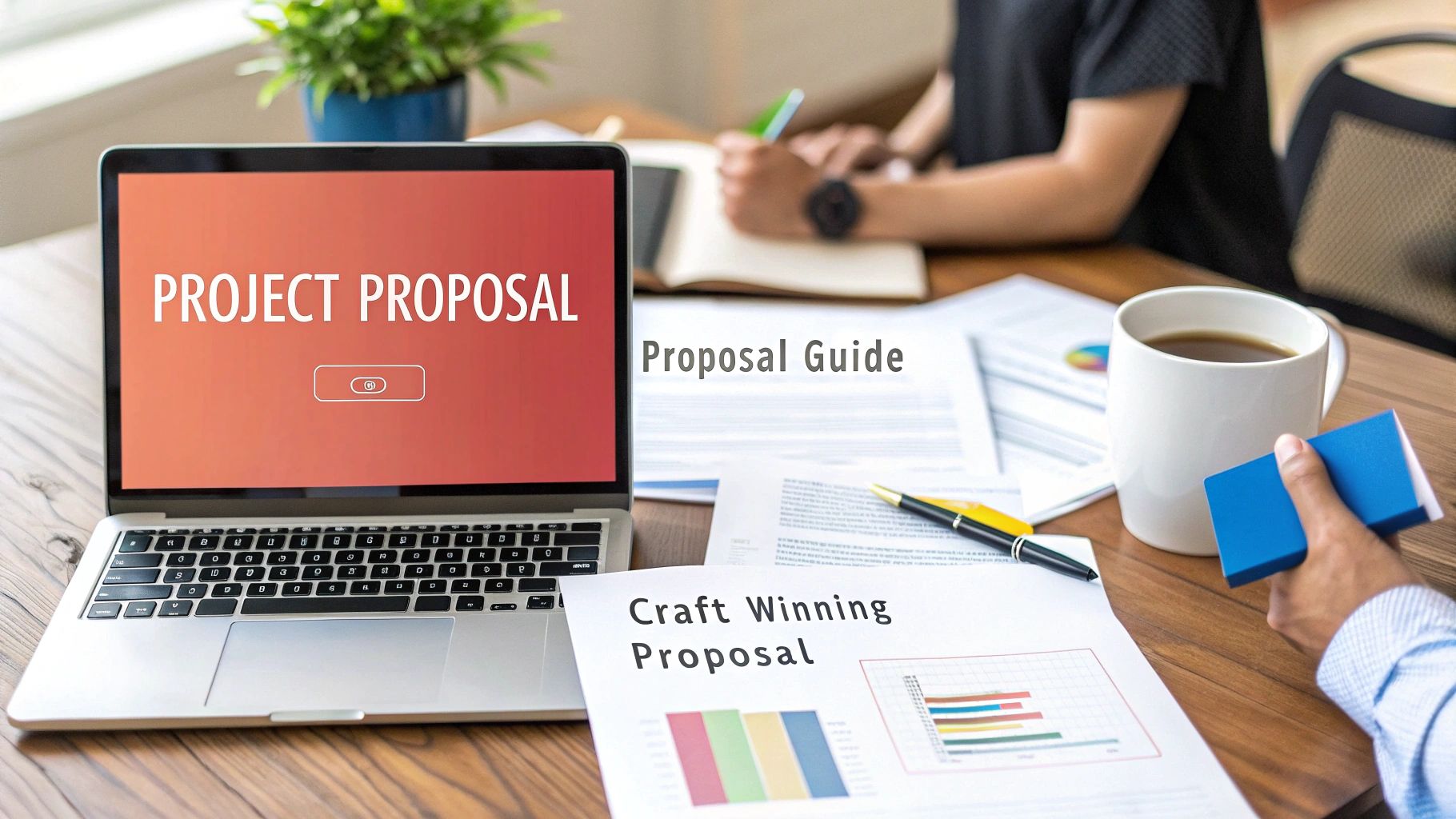A killer project proposal does way more than just list prices. It’s a diagnostic tool, a sales pitch, and your first real chance to prove your agency's value—all rolled into one. Done right, it shifts the entire conversation away from what things cost and toward what we can achieve together.
The Blueprint for a Winning Agency Proposal

Before you even think about firing up a template, let's get one thing straight for your agency. A proposal isn't a quote. It's not just a list of services and prices. A truly great proposal is the first tangible piece of value you offer a client. It shows them you've listened, you understand their real problem, and you have a clear plan to solve it.
The biggest mistake agencies make is jumping straight into the "what we'll do." That's a surefire way to get treated like a commodity, forcing the client to compare your prices line-by-line with your competitors. The foundation of a winning proposal isn't your services; it's the client's goals.
Frame the Proposal as a Strategic Partnership
You want to move the dynamic from a simple transaction to a genuine partnership. This starts by proving you get their big-picture objectives, not just the task they handed you. Every single piece of your proposal—every deliverable, every timeline—needs to tie directly back to their KPIs and the business outcomes they’re chasing.
This isn’t just a nice-to-have; it's a business necessity for agencies. The global project portfolio management market, which hinges on solid proposals, hit $6.13 billion and is climbing. This tells you that businesses are desperate to connect project work to real, measurable business goals.
A truly effective proposal doesn't just answer the client's request; it anticipates their future needs and positions your agency as an indispensable partner in their success. It shows you're thinking about their business, not just the project.
Anatomy of a Client-Winning Agency Proposal
To build that partnership, you need to include the right components. A strong agency proposal isn't just persuasive—it's comprehensive and reassuring. This table breaks down the essential parts that turn a standard quote into a deal-closing document for your agency.
Putting these pieces together in a logical flow shows you're not just a creative agency, but also an organized and professional one—exactly the kind of partner a client wants to hire.
Set the Stage for Client Collaboration
Your proposal should also give the client a feel for what it's like to work with your agency. It’s not just about what you'll deliver, but how you'll get there. This is your chance to build confidence and set expectations right from the start.
A great way to do this is by outlining an essential communication plan for stakeholders right in the proposal. Mentioning how your agency will handle check-ins, reports, and approvals shows you're proactive and transparent. This foresight builds a foundation of trust that can turn a one-off project into a long-term, lucrative client relationship.
Building Your Agency's Proposal Section by Section
A generic proposal is a deleted proposal. Simple as that. If your agency really wants to master how to create a proposal for a project that actually wins business, you have to see each section as a chance to build trust, flex your expertise, and show you get the client's world. This isn't about filling in a template; it's about building a convincing story, piece by piece.
Let's break down the anatomy of a proposal that gets read, signed, and maybe even celebrated. We'll walk through it all, from the make-or-break first impression to the final, value-packed ask.
Crafting a Compelling Executive Summary for Busy Decision-Makers
Let's be real: many clients will read this section and nothing else before deciding if your agency is worth their time. The executive summary is your entire pitch, crammed into a powerful, persuasive snapshot. It’s not a table of contents. It’s the trailer for the movie they’re about to watch.
For an agency, a killer executive summary nails three things, fast:
- Acknowledge their core challenge: State their biggest pain point in one clear sentence. It immediately shows you were paying attention.
- Present your solution's high-level benefit: Don't just list services. Describe the outcome your solution creates.
- State the expected ROI or business impact: Connect your work directly to a real business result, like more leads, higher revenue, or a bigger slice of the market.
Think of it as the "You Said/We Say" model. "You said" your website traffic has flatlined. "We say" our agency's targeted SEO and content strategy will not only drive more traffic but also boost qualified leads by 30% within six months.
Articulating the Client's Challenge with Agency-Level Insight
This is where you prove you understand their problem even better than they do. Don't just parrot back what they said on the discovery call. Your agency's job is to connect the dots from their surface-level symptoms to the deeper, more painful business problem.
A client might say, "We need a new website." A weak proposal just echoes that. A strong one from a strategic agency digs deeper.
Client's Problem (Surface Level): "Our website is outdated and doesn't work well on mobile."
Your Agency's Articulation (Deeper Challenge): "Your current website's poor mobile experience and slow load times are causing a 45% bounce rate among mobile users. This translates to an estimated loss of 200 potential leads per month and is actively damaging your brand's credibility with a key customer segment."
See the difference? This reframing instantly elevates your agency from a pair of hands to a strategic partner who diagnoses and solves real business problems.
Presenting Your Agency's Strategic Solution
Now that you've twisted the knife on the problem, your solution should feel like the only logical answer. Fight the urge to dump a laundry list of every service you offer. Instead, frame your solution as a deliberate, strategic plan designed specifically to solve the challenge you just laid out.
Tell them a story. Explain the "why" behind your "what."
- Weak Framing: "We will do a technical SEO audit, keyword research, and write four blog posts per month."
- Strong Framing: "To rebuild your organic lead engine, our agency will launch a three-phase content offensive. Phase one tackles foundational technical fixes to boost your site's authority. In phase two, we'll pinpoint high-intent keywords to capture immediate, bottom-of-funnel traffic. Phase three will establish your thought leadership through consistent, high-value content, turning your site into a long-term asset."
This narrative approach is way more compelling. It helps the client actually picture the journey you’ll take them on. For a more detailed breakdown of structuring these elements, our complete guide on how to create a winning proposal offers some great pointers.
Defining Scope, Deliverables, and Timelines to Prevent Scope Creep
This is your agency's anti-scope-creep shield. Precision is your best friend here; vague language is your worst enemy. These sections have to be airtight, leaving zero room for "I thought that was included."
Scope of Work: Clearly list what's in and what's out. Being explicit about exclusions is just as critical as detailing inclusions for protecting your agency's resources.
Project Deliverables: Get tangible. Move past fuzzy concepts to define the actual things the client will get from your team.
- Instead of "Social Media Management," try "12 professionally designed social media posts for Instagram and LinkedIn per month, a monthly performance report with key metrics, and one hour of community management per day."
Project Timeline: A visual timeline with key milestones blows a simple list of dates out of the water. It shows you have a clear plan and builds their confidence in your agency's process. Break the project into logical phases (e.g., Discovery, Design, Development, Launch) and attach realistic timeframes to each one.
Knowing who needs to approve what is crucial for hitting those deadlines. The simple stakeholder analysis below shows how to make sure you've accounted for everyone who could speed up—or slow down—the project.

This structured approach helps your agency sidestep those nasty surprises when a key decision-maker you forgot about suddenly appears and throws a wrench in your timeline.
Framing the Investment Around Value and ROI
Finally, the money talk. First rule: never call it "Cost" or "Price." Always, always use the word "Investment." This one-word switch reframes the entire discussion. It’s no longer an expense to be haggled down, but a strategic move toward a future payoff.
Your agency's job here isn't just to present a number; it's to make that number feel like a bargain. Tie the investment directly back to the value and outcomes you’ve already discussed.
Presenting options in a tiered table gives the client a sense of control and choice. Even better, it anchors your fees to tangible results, making the investment feel completely logical. You're no longer selling your agency's time; you're selling them a better future for their business.
Showcasing Your Agency’s Unique Value Proposition

Let's be honest. Any agency can spit out a list of services. But what actually gets a proposal signed? Proving your undeniable value. The market is packed with competitors who probably offer the same things you do. Your proposal needs to cut through that noise and show why your agency is the only real choice.
This is where you stop talking about what you do and start demonstrating how you do it better. It's about strategically weaving in trust signals—powerful social proof and a peek behind the curtain at your unique process. This isn’t bragging; it's a calculated move to make the client feel like hiring your agency is the safest, smartest decision they can make.
Weave in Powerful Social Proof to Build Trust
Clients are wired to avoid risk. Your proposal's core job is to dismantle that fear. And nothing does that better than social proof. It's the ultimate endorsement from a neutral third party. Instead of just telling them your agency is great, you're showing them that other people—just like them—already think so.
Don’t just dump all your testimonials on a single page at the end. That’s a rookie mistake, and it’s too easy for a busy client to skip right over. The real magic happens when you embed social proof right where it matters most.
Here’s how to do it strategically:
- Alongside a specific service: When you propose a "Content Marketing Strategy," slide a punchy testimonial right next to it from a client who saw a 50% jump in organic traffic from your agency's work.
- Within your timeline: As you map out the "Website Launch" milestone, include a mini-case study from a similar project, highlighting how your agency hit every deadline and blew past expectations.
- Right before the price: Just before you lay out the investment, drop in a quote from a client who said, "The investment paid for itself in six months."
This simple technique anchors your promises in reality, making them infinitely more believable and compelling.
Articulate Your Agency's Proprietary Process
Every agency has a "way" of doing things. But the truly successful ones don't just have a process; they name it, package it, and sell it as a unique asset. Your internal workflow is a hidden gem that, when framed correctly, signals expertise, reliability, and superior results. It turns your method from a behind-the-scenes mystery into a massive selling point for your agency.
For instance, a generic agency might say they "develop websites." A strategic agency explains how they use their "Agile Launchpad Framework™." This isn't just a fancy name—it's a structured system you can actually show in the proposal.
Framework Example: The Agency Agile Launchpad Framework™
- Phase 1: Discovery & Strategy: We kick things off with deep-dive workshops and competitive analysis to build a data-backed blueprint for your project.
- Phase 2: Design & Development Sprints: We build in two-week sprints, holding regular check-ins to gather feedback and ensure we're perfectly aligned. No costly surprises.
- Phase 3: Launch & Optimization: After launch, our agency doesn't just disappear. We monitor performance for 90 days, making data-driven adjustments to maximize your conversions and ROI.
Describing your process this way does more than just explain your work. It shows the client you have a reliable system for getting results, which calms their nerves and justifies your price tag.
This structured approach makes your work feel less like an unpredictable art project and more like a well-oiled machine. It builds incredible confidence in your agency.
Showcase Hyper-Relevant Work Samples and Case Studies
Generic portfolios are a thing of the past. Clients don't care about your coolest design or your most technically complex project. They want to see stone-cold proof that your agency can solve their specific problem. Customizing your work samples isn't optional; it's essential.
Instead of just dropping a link to your main portfolio, hand-pick two or three examples that are laser-focused on the client's industry and challenges. For each one, tell a quick story using the "Problem-Solution-Result" framework.
Example Case Study Snapshot:
- The Client: A B2B SaaS company in the cybersecurity space.
- The Problem: Their blog was attracting the wrong kind of traffic, leading to zero demo requests from their content.
- Our Agency's Solution: We built a new content strategy around high-intent keywords and created a series of technical guides that spoke directly to decision-makers.
- The Result: We increased qualified organic traffic by 120% and started generating an average of 15 new demo requests every month, directly from that content.
A mini-case study like this is so much more persuasive than a simple link or a screenshot. It draws a straight line from your agency's past successes to the client's future goals, making it easy for them to picture you as their partner.
Using the Right Tools to Create Agency Proposals Faster
Let's be honest: writing a custom proposal from scratch for every single lead is a huge time-suck. It's one of the fastest ways to tank your agency's profitability, pulling your best people away from strategy and into repetitive admin work. If you want to scale your agency and actually win more deals, you have to work smarter, not just harder. Technology is the key.
The right proposal and project management software can completely overhaul your agency's workflow. These tools are built to handle the grunt work, which frees up your team to focus on the strategic thinking that actually closes deals. For agencies struggling with how to create a proposal for a project without burning out, this is your answer.
The Shift to Digital-First Proposals for Agencies
Static PDFs are starting to feel like a relic from a bygone era. The top agencies are all moving to digital-first proposals. These aren't just documents; they're interactive, engaging sales experiences that give you a ton of insight.
Imagine sending a proposal where your potential client can:
- Watch a short, personalized intro video from your agency's account lead.
- Click through an interactive pricing table to build a package that fits their exact budget.
- Legally sign the document right then and there with an integrated e-signature, turning a weeks-long process into minutes.
This approach doesn't just look more professional; it massively shortens your agency's sales cycle. You're making it incredibly easy for the client to say "yes," removing all the friction and keeping the momentum going.
A great proposal tool doesn't just help your agency write faster; it helps you sell better. It provides analytics that show you exactly which sections a client viewed, how long they spent on the pricing page, and when they forwarded it to a colleague, giving you invaluable intel for your follow-up.
Automating Administrative Headaches for Better Agency Efficiency
Beyond just creating the proposal, the right tech stack can handle all the tedious work that surrounds it. The goal for your agency is to build a smooth, connected process from the first conversation all the way to project kickoff.
This is where integrating your proposal software with your project management tools becomes a game-changer. The market reflects this trend, too. The project management software market is expected to jump from $7.24 billion in 2025 to over $12 billion by 2030. What's really interesting is that smaller businesses are adopting these tools faster than big corporations, showing a real push to compete by being more efficient. You can dig into these project management software statistics to see what this means for agencies like yours.
Think about how the right tools connect the dots for your agency:
- Intelligent Templates: Instead of starting from a blank page, you pull up a master template that automatically populates standard sections like your 'About Us' page or relevant case studies.
- Automated Follow-Ups: You can set up automatic reminders to gently nudge clients who haven't opened your proposal, so no opportunity ever slips through the cracks.
- Instant Project Creation: As soon as a proposal is signed, the system can automatically create a new project in your go-to tool (like Monday.com or Asana), assign the team, and populate the first set of tasks based on the scope they just agreed to.
This kind of automation lets even a small agency operate with the polish and efficiency of a much larger enterprise. It makes for a seriously smooth and impressive client experience right from the get-go.
Avoiding Common Agency Proposal Mistakes That Lose Deals

It’s a high-stakes moment. You’ve had a killer discovery call, built genuine rapport, and mapped out a brilliant solution. Then, the deal collapses—all because of a tiny, avoidable mistake in the proposal.
Even the smallest error can make a potential client question your agency's professionalism and attention to detail. It plants a seed of doubt about your ability to deliver on your promises.
Think of this as your agency's pre-flight checklist. We’re going to walk through the classic, deal-killing mistakes we see agencies make over and over again. Learning to spot and sidestep these pitfalls will dramatically boost your win rate.
Mistake 1: Using a One-Size-Fits-All Template That Screams "Generic"
Sending a generic, fill-in-the-blanks proposal is the fastest way to show a client you don't really care about their business. When they see boilerplate language that could apply to anyone, they immediately feel like just another number on your agency's list.
This impersonal approach kills any chance of building a real partnership before it even starts.
Instead of a rigid template, the smartest agencies use a modular master proposal. This is essentially a library of high-quality, pre-written content blocks you can pull from—think case studies, specific service descriptions, and team bios.
This strategy gives your agency the perfect balance of efficiency and personalization. You can quickly assemble a proposal, but you're also able to customize it by pulling in the most relevant case study or echoing the exact language the client used on your discovery call.
Mistake 2: Writing a Vague or Ambiguous Scope That Invites Conflict
"We will manage your social media" isn't a scope of work; it's an open invitation for conflict down the road. Vague scopes are the number one cause of scope creep, client disputes, and painful revisions for agencies. If there's any ambiguity, you can bet the client’s interpretation will be far more generous than yours.
Your scope of work needs to be airtight. It must be a crystal-clear list of what is included and, just as importantly, what is not included.
- Vague: "Website design services."
- Specific: "Design of five core web pages (Homepage, About, Services, Blog, Contact) with up to two rounds of revisions per page. This engagement excludes logo design, brand guide creation, and copywriting."
This level of precision gets rid of assumptions and sets firm, professional boundaries from day one. Establishing clear boundaries is a critical part of running successful projects, a topic we explore in our guide on project management for agencies, which details how this upfront clarity prevents major headaches later.
An airtight scope of work is your agency's best defense against future misunderstandings. It protects your agency's profitability and ensures the client knows exactly what to expect, fostering trust through transparency.
Mistake 3: Focusing on Your Agency Instead of the Client's Success
Here's a hard truth: your client doesn't really care about your agency's founding story or your long list of awards. They care about one thing and one thing only: solving their problem. A classic mistake is dedicating way too much proposal space to talking about your agency and not nearly enough to the client's future success.
You have to flip the script. The entire proposal should be framed around them. Every single section should answer their unspoken question: "What's in it for me?"
Instead of a long "About Us" section right at the top, weave your credibility in contextually. Place a relevant client testimonial right next to your proposed solution. Insert a mini-case study that directly mirrors the challenge they're facing. This proves your agency's expertise without making it all about you.
Finally, remember that the document itself represents your agency's commitment to quality. To ensure your printed proposals are flawless, it’s smart to use a printing quality control checklist to catch any errors before it ever reaches the client. It’s a small step that reinforces your commitment to excellence in every detail.
Mastering the Follow-Up to Seal the Deal for Your Agency
Hitting ‘send’ on your proposal isn’t the finish line—it’s the start of the final lap. It's shocking how many agencies drop the ball right here. You can pour weeks into crafting the perfect proposal, only to have it die a slow death in a client’s inbox.
The truth is, the follow-up is where you turn a ‘submitted’ document into a ‘signed’ contract.
A professional, non-pushy follow-up strategy is an absolute game-changer for any agency. It signals that you’re proactive, confident in your value, and genuinely interested in a partnership. The goal is to keep the momentum going without becoming a pest. This final piece of the puzzle is often what separates the winning agencies from everyone else.
Establish a Respectful Follow-Up Cadence to Stay Top-of-Mind
Your follow-up process should be just as thoughtful as the proposal itself. Before your agency even sends the document, have a clear timeline in your head for when and how you’ll reach out. A random, disorganized approach just looks desperate. A well-timed cadence, on the other hand, shows you're a pro and keeps your agency top-of-mind.
A great follow-up isn't just a "Hey, did you see my email?" poke. It's an opportunity to add more value. Each time you get in touch, your agency can offer a little more insight or answer a question before they even think to ask it.
For a deep dive into the nuts and bolts of this, check out our ultimate guide on how to write a follow-up email. It’s packed with templates and real-world examples you can adapt for any agency situation.
Your proposal should never just end on the pricing page. The very last thing they see must be a clear "Next Steps" section. Prompt them to book a quick 15-minute call on your calendar to go over any questions. This builds the first follow-up action right into the document itself.
Navigating Client Objections and Revision Requests with Confidence
When a client comes back with a question or an objection, don't get defensive. Get curious. This is actually a buying signal. It means they're taking your proposal seriously and are just looking for a bit more reassurance before they commit. Address their concerns with confidence, always tying your answers back to the value and ROI your agency has already laid out.
Revision requests are pretty common, but you have to handle them carefully to avoid scope creep and devaluing your work. If they ask for changes, your immediate response should be to suggest a call to discuss them. This stops the endless email back-and-forth and lets your agency stay in control of the conversation, protecting your scope and your sanity.
Having a disciplined process like this is what leads to success. Think about it: major grant programs like the Stanford Global Health Seed Grants follow incredibly strict timelines. Their proposals are due by March 28, 2025, with awards announced by May 16, 2025. This kind of structure creates clarity and transparency, which statistically boosts success rates. By adopting a similar, disciplined approach, your agency can guide your prospect smoothly from 'considering' to 'convinced'.
Turn every client conversation into a growth opportunity with Scribbl. It automatically summarizes your meetings, identifies action items, and uncovers upsell opportunities, giving your agency an unbeatable edge. Discover how Scribbl can transform your client management today.




